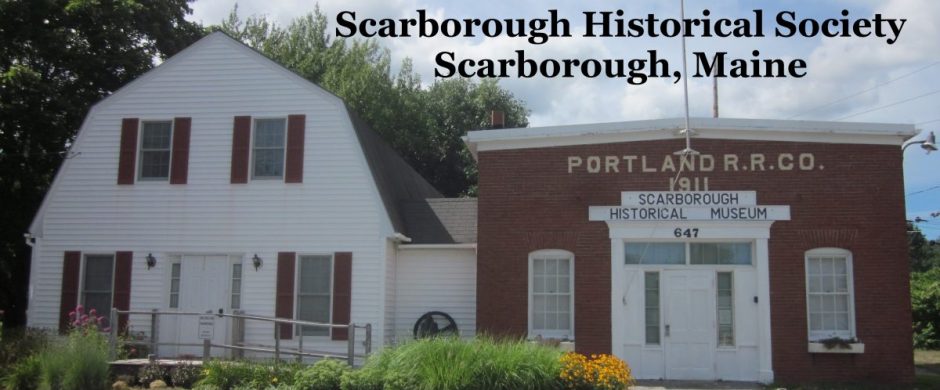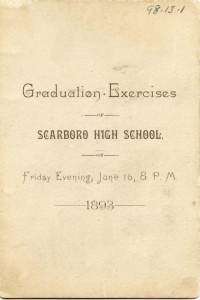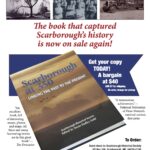Part 3 of 4
The school system in Scarborough has seen many changes over the past 352 years. To demonstrate to you how far we have come in education, Scarborough Middle School students invite you to travel back in time to witness the evolution of a variety of things found in any Scarborough classroom today.
Graduation
Kristen, grade 7
Graduations ceremonies have not always been what they are now. In the past, diplomas were still handed out, but they were very different. Diplomas were made with sheepskin, were hand- written and tied with a ribbon. This is where the saying “Hang your sheepskin on the wall” came from. The diplomas were rolled, but because it became hard to hang them, they are no longer rolled. In the past, very few kids attended school every day because of work at home. This made it so very few kids actually graduated. Fortunately, the number of kids graduating has increased over the years.
In 2010, almost 300 kids are graduating from Scarborough High School. Diplomas are still handed out, but they are not rolled. They are often plastered onto a mat to make them firm. Often people frame them and hang them in their house. Now “Pomp and Circumstance” is played while students are graduating and receiving their diplomas. This is how graduations have changed.
Slates and Slate Pencils
Laura, grade 7
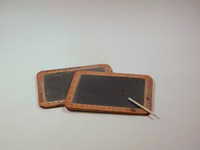
Photo of slate boards taken by students
Over the years, the writing utensils that students use have drastically changed. In the past, kids wrote on small tablets called slates with thin cylinders of rock called slate pencils. These slates were approximately book-sized and were carried with the student to and from school each day. Because everything that was written on the slates was erased, kids had to memorize everything they were taught during the school day. In those days, a good memory characterized a good student.
Eventually, slates and slate pencils were discarded and manufactured pencils and paper were used. These had many benefits that the slates did not have. For example, slate pencils were very wide, which made it hard to write neatly and quickly. The new writing utensils did not have these disadvantages and were considered a great invention. Slates and slate pencils are no longer used for writing but are an integral part of the history of our schools. Without them, who knows where we would be now?
Books
Talya, grade 7
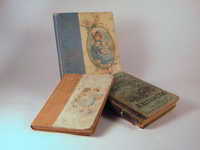
Photo of books taken by students
In early times, classroom books were quite different. Back then, there were multiple books in each classroom, for a while there was only one. The first book introduced to classrooms was the Bible. It was used for most of the children’s education, not only for its content but for building basic reading skills. Much of the school day was devoted to memorizing and reciting passages from it and practicing penmanship by copying them down.
Putting aside the Bible, the first true schoolbook was a textbook entitled “New England Primer” and was used between 1760 and 1843. The most popular schoolbook of the nineteenth century was first introduced in 1936 and it was entitled The McGuffey Reader. The Reader sold tens of millions of copies only in the nineteenth century alone. The books came in a set of six and each book progressed in difficulty for each student’s separate reading needs. They also helped making teaching classes of mixed ages and grades easier to manage. The books were used for teaching literacy and, like the Bible, basic values.
In Scarborough at 350: Linking the Past to the Present, Francis K. Marsh, remembers books in school.
“That first day, the teacher laid a big geography book on my desk and another one on Joe’s to keep us occupied while she attended to paperwork from other classes. No one heard a peep out of us for the rest of the day. With those pictures to spark curiosity and all those unknown words to wonder at, by the time four o’clock came, the first grade was totally motivated. It wasn’t long before Joe and I had another book put into our hands. It was green with orange letters and said something like A Child’s First Reader. On the first page we were introduced to Dickie Dare, who taught us much about the printed word.”
Now in our schools we have many textbooks for each subject. It is also common for online books to be used and Internet sites full of information. We still use the standard books for reading in class and for the usual research and such, but we are not completely dependent on them as they were in the past
Pens, Ink, and Paper
Isabelle, grade 7
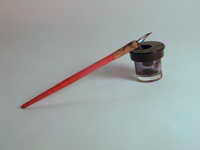
Photo of pen and ink taken by students
Quill pens and ink were commonly used before pencils and regular pens were invented. Quill pens were used for writing that would be exhibited or important writing tasks, since penmanship was considered an important skill and the appearance was more important than the accuracy. The teacher would whittle the tips of the quills out of goose feathers, and they also made the ink. In the cities, the ink was easier to make, because the ink consisted of only ink powder and water mixed together, while in the country, it was made of lampblack or tannic acid from oak trees mixed with light oil. Ink could also be made from swamp maple bark and copperas. Writing with quill pens and ink could be very messy, so the students used blotting paper to soak up any excess ink from the pages to prevent smearing when they were finished.
In the 1870s, mass-produced paper was inexpensive enough to use in the everyday classroom which allowed students to write and keep longer pieces of work. Although some artists use ink today for certain pictures, we mostly use pens that do not require refilling of ink. In fact, students at Scarborough Middle School barely use pens and pencils for writing because they use laptops to electronically type out their work
Bells
Jonathan, grade 6
In the nineteenth century, kids would play in the school yard before school. When it was time for kids to come in a teacher would stand in the doorway and ring a bell unless the school had a bell tower. Kids needed to stay close enough to the school so that they could hear the bell or they would be punished for being late.
Today some schools use a bell or buzzer over the intercom to tell when a class period ends. This system provides structure for kids who have to go to many different classrooms during the day. Classes end when the bell rings so teachers have to plan their lessons to fit the period lengths. However, at Scarborough Middle School we don’t use bells for this purpose.
